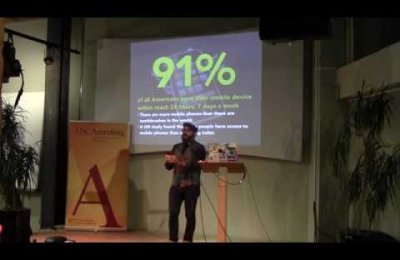USC Annenberg faculty and graduates participated in the annual 2016 Online News Association conference in Denver last week, which brought together journalists, students, designers, and educators from across the world for a three-day immersion in emerging technology and digital media.
Robert Hernandez, associate professor of professional practice in journalism, moderated three conference sessions-- “Virtual Reality Technical Town Hall,” “Table Talk on VR Journalism,” and “Hype or Here: When should I use 360/VR in my Storytelling?”--and was a panelist on “Journalistic Standards in a Virtual World.” Those sessions highlighted virtual reality tools and also examined the crucial question of when VR technology aids rather than detracts from storytelling.
Hernandez is the co-founder of #wjchat, a weekly Twitter chat for web journalists and is currently serving on the ONA Board.
Virtual reality has grown by leaps and bounds in just the last few years, he said.
“The community that has been there from the beginning has started to gel,” Hernandez said. “You are seeing the level of quality and goals and production value increase and we are doing it together.”
The next phase of virtual reality storytelling will revolve around “360 'video,' because that is something we understand in newsrooms.”
“True VR is truly immersive—I can walk around and interact with the space. You are going to see more of those developments,” Hernandez said.
Hernandez recruited a USC Annenberg graduate to attend the conference with him this year. For his first time at ONA, Kevin Tsukii (B.A. Print and Digital Journalism ‘16) spoke with a group of panelists on “Quick Guide to your Basic 360/VR Toolkit.” The session covered affordable cameras, audio equipment and software to get started for making 360 video and virtual reality projects.
Tsukii is the immersive video lead on 360 video and live-action experiences at Emblematic Group, a studio founded by virtual reality journalist Nonny de la Peña. The Group specializes in producing content for the Oculus Rift and other customized goggle and tracking systems. Previously, he worked on the Los Angeles Times Datadesk and designed motion graphics for Al Jazeera America.
For Tsukii, it was exciting to see so many people interested in virtual reality.
“Virtual reality has become more popular recently because the technology to support it has gotten better,” he said. “And it’s people understanding virtual reality can be consumed on the phone, you don’t have to buy an $800 headset. It’s readily available on Google Cardboard or a Samsung phone.”
P. Kim Bui, an Annenberg adjunct professor who is teaching JOUR 309: Introduction to Online Media this fall, discussed distributed content, posting straight to social media instead of a news site, Facebook Live and more at “Keynote: reported.ly: The Story of Digital Media” and “Welcome to Snapocalypse: Navigating, Surviving … and Thriving? … With Distributed Content.” During the keynote, Reported.ly founder Andy Carvin, Bui, and other Reported.ly staffers discussed how the groundbreaking social media website, with a focus on human rights and social justice news, came together in 2014.
“We were witnesses and we reported the news, but we were also empathetic and kept in contact with sources. A lot of our ethics and practices were formed when we wrote out core values,” Bui said of the new site.
Bui is Reported.ly’s deputy managing editor. She’s also a co-founder of #wjchat with Hernandez and others.
For Bui, the bulk of conversations around the role of digital media in the newsroom-- how can newsrooms can be faster when delivering the news? What are the smartest uses of social media -- all come down to bare-bone reporting and engaging sources, among other things.
Bui said ONA has been “one of the foremost places” for her to meet and talk to other journalists about what the future of digital news will be.
“One of the reasons I love it so much is that we come together to talk about how to remain true to the journalistic principles that made us fall in love with our job, but also take part in the changing digital landscape,” Bui said. “Faster isn’t always better, sometimes it’s about deeper, adding context, or being right.”







